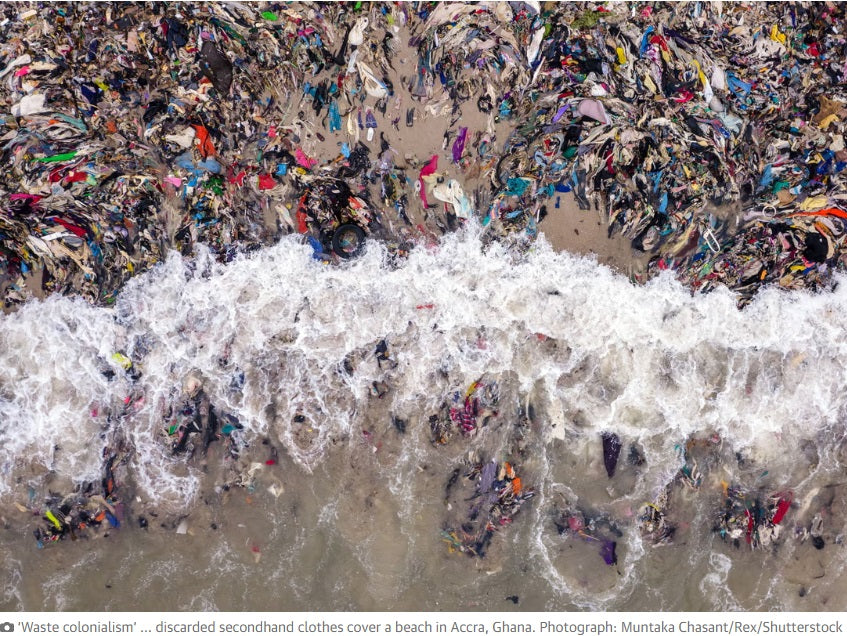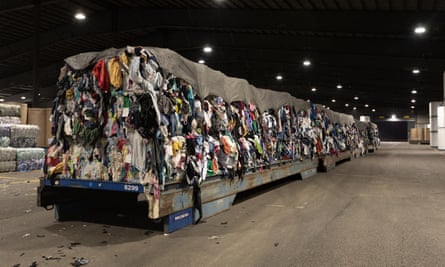
‘The missing link’: is textile recycling the answer to fashion’s waste crisis?
‘The missing link’: is textile recycling the answer to fashion’s waste crisis?
Millions of tonnes of T-shirts and dresses are dumped or burned every year. Turning old clothes into new ones is possible – the question is whether it is a realistic solution
Story by Lucianne Tonti
Published in The Guardian, Wed 18 Oct 2023 17.00 BST
The sun is always shining in the Swedish seaside town of Sundsvall, according to the staff of Renewcell, the world’s first commercial-scale textile-to-textile recycling factory.
Renewcell’s enormous warehouse opened last year. It sits on the water’s edge, with easy access for the ships that deliver 400kg bales of shredded cotton and denim from textile waste sorters in Germany, Switzerland and Sweden. Inside the warehouse, the large rectangular bales are stacked in colossal fabric pyramids, each exploding with ribbons of navy blue and black fabric. The towering piles weigh 500 tonnes. Every month, the plant can take 10 times that amount and turn it into a material called Circulose. Circulose looks and feels like chalky craft paper, but it can be used to make viscose rayon (usually made from wood pulp) and, in turn, new clothes.
“Instead of sending [textile waste] to landfill or incineration, we want to pick it up and be that circularity,” says Patrick Lundström, the CEO of Renewcell. “We see ourselves as the missing link in the fashion industry.”

(A drop in the ocean … a textile delivery awaits treatment at Renewcell. Photograph: Felix Odell)
The opening of the plant could not come soon enough. The question of what to do with the mountains of textile waste produced by the fashion industry is increasingly pressing. Images of used garments strewn across the beaches of Ghana and the dunes of the Atacama desert in Chile highlight the truth of waste colonialism – the practice of big waste producers such as the UK offloading their waste on to poorer countries without effective waste management – and reveal how overproduction has rendered piles of T-shirts, dresses and jeans worthless to charities and resellers.
But the 60,000 tonnes of textile waste Renewcell will be able to process by next year is a drop in the ocean. The EU and Switzerland generated 7m tonnes of garment waste in 2020. By 2030, this figure is expected to be more than 8.5m tonnes. About 70% of this gets thrown out with ordinary household waste and goes directly to landfill or incinerators, according to the management consultancy McKinsey. About 30% is collected via donation bins, take-back schemes and charities. The better-quality garments are taken and resold by vintage or charity stores within Europe; the leftovers are exported to Africa and Asia to be sold in their secondhand markets.
But a report published in February by the sustainable fashion foundation Changing Markets suggested that as much as half of the castoffs sent to the global south are of such poor quality that they end up being dumped in rivers or sold to be burned for (very toxic) fuel. The amount turned back into new clothing is estimated to be between 0.1% and 1%.

(Factory of the future? Renewcell’s facility in Sundsvall. Photograph: Renewcell)
Companies other than Renewcell have chemical recycling technology, which creates virgin-quality fibres that can in theory be recycled on a loop, but progress towards achieving commercial scale has been slow. The Hong Kong Research Institute of Textiles and Apparel (HKRITA), for instance, opened a plant in Indonesia in 2021, but it recycles fewer than 1,000 tonnes annually. “Without getting [more] recycling systems operating at significantly higher scale, we will not be able to catch up with the industrial and post-consumer waste being generated,” says its CEO, Edwin Keh. Mechanical recycling of textiles has existed for years, but it accounts for a tiny percentage of the fibre market and produces materials that have to be blended with virgin fibres to be useable as clothing.
The problems that vex textile recyclers tend to be the same: a need for single materials that is complicated by blended fibres (which make up most of our clothes); a lack of infrastructure for collecting and sorting textile waste; and a difficulty procuring sufficiently large orders to justify the investment to build big enough factories.
Renewcell had some advantages when it came to industrialising. It took over an old paper mill that was already using 100% renewable energy and had some of the required infrastructure. A partnership with the H&M group and the not-for-profit Canopy led to orders from fashion brands including Levi’s, Ganni and Filippa K. Even so, it has reported weaker-than-expected sales; on 16 October, it announced that Lundström would be departing as CEO, with the company reportedly hoping that new leadership will spark an uptick in orders.

(The price of overproduction … clothes discarded in Chile’s Atacama desert, near the city of Iquique. Photograph: Martin Bernetti/AFP/Getty Images)
The process at Renewcell can handle cotton textiles that contain up to 5% synthetic materials, but Lundström says it is working to expand this. In Renewcell’s labs, Circulose can be recycled up to seven times. The hope is to increase capacity at the Sundsvall plant to 120,000 tonnes in 2024; they are exploring opening locations in the US, Asia and Africa. “There are no excuses any more,” says Lundström. “Our promise is to process 100% of textile waste. We are creating that circularity.”
The textile waste crisis is starting to catch the attention of legislators. Soon, extended producer-responsibility schemes will make brands accountable for the end-of-life phase of their products. In the EU, the destruction of unsold goods will be banned from 2024 and, by 2025, textiles will be collected in a separate waste stream, similar to paper and glass. The UK is yet to legislate on the matter, but, in July, the environment minister Rebecca Pow launched a programme that includes proposals to stimulate circularity and create a textile recycling industry.
These moves represent a significant shift in awareness of how rapidly the garment industry has collapsed into one of take-make-waste. But the ever-increasing speed of production and the rise of ultra-fast fashion brands such as Shein and Boohoo mean the gap between the volume of waste created and the capacity of textile recyclers will continue to widen.
In some respects, fast-fashion players are working to find solutions. H&M has a 10.37% stake in Renewcell and is already selling clothes made from Circulose. Since 2013, it has run a take-back programme through collection bins in its stores. Its ambition, according to Cecilia Brännsten, the head of resource use and circular impact at H&M Group, is to use “textile waste from production to build the raw material that we use for our garments”. But the lack of recycling infrastructure and capacity makes this ambition hard to reconcile with a business model built on mass production.
Plus, H&M’s take-back scheme has long been plagued with questions about its efficacy. In the 10 years it has been operating, the programme has collected 155,000 tonnes of textiles for resale and recycling, but some sources suggest their production volumes are as high as 3bn garments annually. In its report, Changing Markets reported finding garments from fast-fashion brands, including H&M, in landfills, or burned in Kenya. This is “a symptom of a very linear industry where the pieces of the puzzle do not fit yet”, says Brännsten.
The truth is that the fashion industry produces too many clothes. In the years it will take textile recyclers to build industrial-scale factories, hundreds of billions more garments will be made – and discarded. “Recycling is perhaps the last resort to address waste,” says Keh. “It is much better not to create waste, or to waste less in the first place.”


















